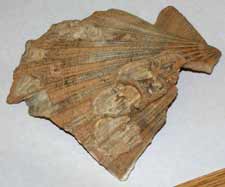Story #1
|
| It appears to be a cross-section of some kind
of branch - very strong growth rings are apparent. However,
one side has been rotted or chewed so perhaps one part was lying
in a damp environment - therefore one side was exposed or buried
and the decomposition occurred after death. |
 |
|
Story #2
|
 |
Teeth - small, fragile and very evenly worn rows. The teeth
belonged to an herbivore.
The animal died and the teeth became mineralized.
|
|
Story #3
|
| Two fish, but different preservation. One died
and decayed - it looked sort of exploded. Perhaps it was lying
on the sea floor surface and was scavenged. The other is well
preserved and its scales are intact, thus it probably was buried
quickly after death. |
 |
|
Story #4
|
 |
Part of a scallop shell. Probably broken after death, but
can't tell if it was broken before or after it was buried.
There were barnacles growing on it, but can't tell if the
barnacle settled before or after the death of the scallop.
However there is a second, smaller barnacle within the first
one! So that had to happen after barnacle #1 had died (real
estate take over).
|
|
Story #5
|
| Four similar shells with horizontal and vertical
ridges (may be indicative of age). One organism burrowed through
the shell, creating a vertical hole. Others left tracings that
are more worm-like in appearance. In one case, there appears
to be come kind of calcium deposit as if the shell were reacting
to invasion, therefore growth around the original scar. Therefore
this had to happen before death. One shell has both sides intact
therefore it must have been buried quickly and in-filled with
sand. |
|
Story #6
|
 |
Leaves. There are layers of compound leaves underneath
a single leaf, therefore sort of like leaf litter. It must have
been a forest environment. Some leaves are still together -
again, that means that they must have been buried quickly. |






